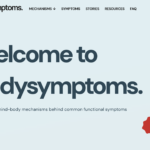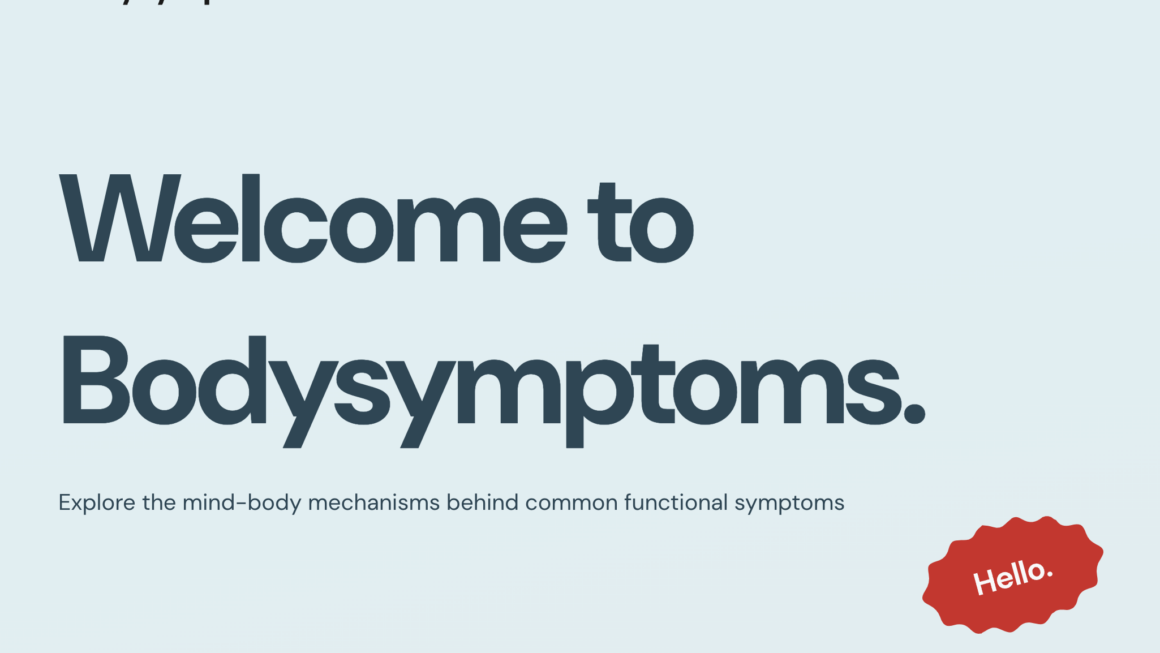Author: Lina Münker.
People with FSS frequently struggle to find reasonable explanations for their symptoms. This is potentially due to the complexity of FSS development, suggested to involve a variety of underlying multifaceted interactions from biological, psychological and social domains of functioning, and as well as the various presentations both within and across people. In addition, there is a lack of training for health care professional in the domain of FSS, and time restrictions in current health care settings to explain symptoms properly.
Recently, Dr. Google has become a very popular strategy to gain information on symptoms. The deficient current state of appropriate online guidance on FSS therefore represent a problem Saunders and their colleagues aimed to tackle (Saunders et al., 2024). The authors designed an interactive web resource which they called https://bodysymptoms.org/ to communicate and help understand FSS, through the use of a participatory design, namely patient and public involvement (PPI). Such a tool, by now, does not seem to exist yet.
The PPI approach has evolved into a popular approach in health research for people from various backgrounds to be meaningfully involved in the process of creating knowledge and learning in a mutual way with and from each other. In turn, this is incredibly important and resourceful when designing online, or so-called e-health, tools. Saunders and colleagues constructed their participatory design study in 4 phases roughly characterized by planning and recruitment, scoping, development and scaling. People with lived experiences, project and research leaders and web-developers got together in a series of workshops to discuss the wide range of possible FSS explanations which deemed meaningful. Meanwhile, content and design of the interactive web resource was developed through an ongoing iterative process of re-writing existing scientific and new material to make it understandable for laypeople. Additionally, upon individual interests and how goals of involvement were set at the beginning of the project, participants with lived experiences were invited to take part in website content and design creation. Consecutively, the prototype of the web resource was evaluated using the think aloud method together with potential end users of the final product, which involves speaking out thoughts as they come while trying the web application.
Overall, the researchers were able to recruit seven people with lived experiences from various European countries, who were more or less engaged in the project process according to their wishes and who now share their stories on the web resource. Additionally, and in accordance with the original PPI idea, the participants shared a positive evaluation of being involved throughout the process, where they felt heard and respected. When reflecting on potential challenging parts, participants highlighted amongst others the importance of potential pitfalls with an interactive, openly accessible online tool, leading to revisions of the website.
By now, bodysymptoms.org includes features which allow the user to personalize their experience. The web resource contains various pages on a framework and general explanations of symptoms, a symptoms quiz to provide a starting point, the personal stories written by the people with lived experiences as well as resources from external guides and patient organizations. Bodysymptoms.org is available in English and Dutch, and versions in Danish, French and Spanish are underway, which has also facilitated the process of discussing cultural considerations in the content of the web resource.
Through their PPI methodology, Saunders and their research team were able to create a new and fruitful, easily accessible and efficient online tool, with the ultimate goal of improving the understanding and explanation of FSS to the wider audience. A great advantage of this project was the unique opportunity to give people with lived experiences a voice to tell their stories and thereby empower them to share their experiences. Through this continuous process of dialogue and reflection, mutual learning was encouraged, and an interactive web resource describing how the mind and body systems operate together, while using a holistic approach, is now available to help people understand symptoms on the individual level.
Lina Münker is a psychologist, with a background in developmental and health psychology. She is currently pursuing her PhD at the Department of Child and Adolescent Psychiatry Aarhus University Hospital Psychiatry and the Department of Functional Disorders and Psychosomatics, Aarhus University Hospital, in Aarhus, Denmark.
Saunders, C., Gordon, M., Righini, C., Pedersen, H. F., Rask, C. U., Burton, C., & Frostholm, L. (2024). Participatory design of bodysymptoms.org: An interactive web resource to explain multisystem functional somatic symptoms. Journal of Psychosomatic Research, 111827.
This project has received funding from the European Union’s Horizon 2020 research and innovation programme under the Marie Skłodowska-Curie grant agreement No 956673. The article reflects only the author’s view, the Agency is not responsible for any use that may be made of the information it contains.








